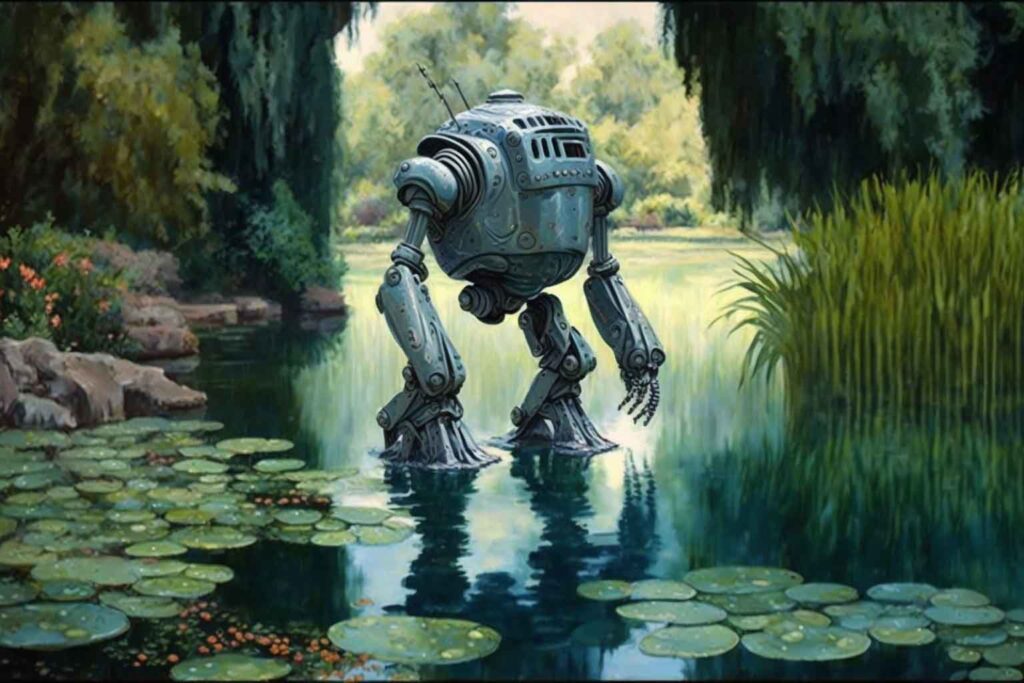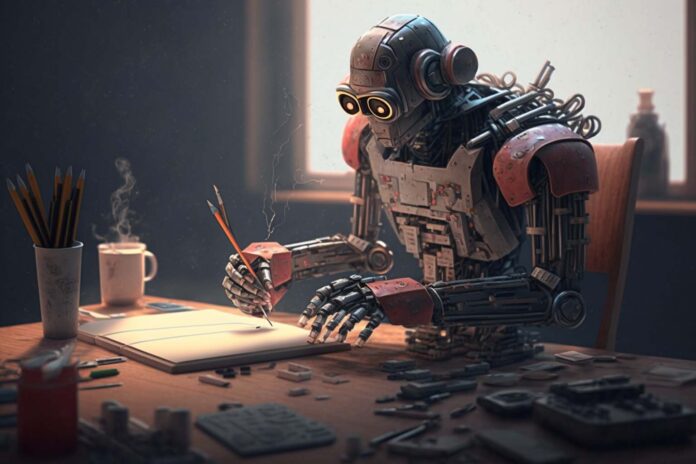Generative AI is the buzzword of 2023. We see it almost daily on Twitter, hear it from our friends at work at it keeps popping up everywhere. People are sharing artworks created by generative AI applications like DALL-E or Midjourney, sharing useful ‘prompts’ that you can use with ChatGPT, the virtual assistant from open.ai.
In our Artificial Intelligence Basics series, we are answering the questions related to AI that has been asked quite a lot lately. In this article, our focus is on the “What is Generative AI?” question. While the word generative is defined as “capable of producing or creating”, but it comes to AI, it has a deeper context to it.
To make this info as bite-sized as possible, we have divided the article into 10 sections. Feel free to jump to any section if that’s your thing!
- 1. Introduction to Generative Artificial Intelligence
- 2. Understanding Generative AI: The Basics
- 3. History and Evolution of Generative AI
- 4. Types of Generative AI
- 5. Applications of Generative AI
- 6. How Generative AI Works
- 7. Generative AI vs Discriminative AI
- 8. Advantages and Limitations of Generative AI
- 9. Key Players and Pioneers in Generative AI
- 10. The Future of Generative AI: Opportunities and Challenges.
- AI: Beyond the Buzzwords (Bonus Section)
1. Introduction to Generative Artificial Intelligence
We bet you have seen robots painting pictures and creating not-too-bad house music out of thin air in Sci-Fi movies. In simple terms, Generative Artificial Intelligence (AI) tools or apps do exactly this. Generative AI a type of AI that generates new and unique content based on patterns it has learned been thought from existing data (a.k.a. training data).
Think of it like a robot version of Gordon Ramsey (with less profanity, obviously) in a kitchen. It has a pantry full of ingredients and spices and it remembers all the food that has ever been cooked and how they are cooked (that would be the training data). When you ask him to cook Ratatouille, he knows that there are many variations of it and creates something new and creative. In case of current Generative AI tools at our disposal, texts, images and videos replace the Ratatouille.
So, you might be wondering why is Generative AI so exciting and everyone is taking about them? Well, for starters, it has the potential to revolutionize the way we think about creativity and originality. Generative AI apps have the ability to create newish things that no human ever has! We say newish, because ultimately these tools are training on millions (and sometimes billions) of previous work made by humans. Generative AI applications has a wide range of practical applications in fields such as arts, design, advertising, and much more. So, if you’re ready to learn more about this cutting-edge technology, keep reading!
2. Understanding Generative AI: The Basics
So, how does Generative AI actually work, you might wonder. Simply put, it starts with a model that is trained on a large dataset of existing content. This model then uses that information to generate new and unique content based on the patterns and rules it has learned. The generated content can be anything from a new piece of music, to an entirely new product design, and even very impressive images similar to great artists styles of the earlier times.

Generative AI can also be used in a variety of ways, such as creating personalized content, completing tasks that are too tedious or time-consuming for humans. For example, one promising aspect related to that is creating personal assistant that will analyze the text you input, for example your medical history documents, and act as your own medical history database ready to answer any questions your doctor may ask you when you visit them.
It’s important to note that Generative AI is not just a one-time solution. It continuously improves and evolves as it receives more data and feedback. After the release of text-based generative model GPT version 2 in 2019, and ChatGPT Model 3.0 in late 2022, now open.ai is planning to release version 4 very soon in 2023. This means that the content it generates becomes more and more refined over time, and it can even learn to generate content in new and innovative ways. So, whether you’re a tech enthusiast or just looking for new and creative ways to solve problems, Generative AI is definitely worth keeping an eye on.
3. History and Evolution of Generative AI
The history of Generative AI can be traced back to the 1940s and 1950s, when scientists first began exploring the idea of machines that could generate new and unique content. However, it wasn’t until 2022 that Generative AI really took off with the help of modern computing and the development of deep learning algorithms.
In recent years, Generative AI has made significant advancements and has gained a lot of attention in the tech world. This is due in large part to the success of Generative Adversarial Networks (GANs), which is a machine learning algorithm proposed by the American Scientist Ian Goodfellow (former employee of Google and Apple), have shown the ability to generate highly realistic images, videos, and even 3D models.
As an impressive feat, engineers at Samsung demonstrated a GAN-based algorithm that produces videos of a person speaking, with only a single photo of that person as the input.
As Generative AI continues to evolve and improve, it has the potential to change the way we think about creativity, content creation, and problem-solving. But at the same time it is important to note that there are a lot of ethical and privacy issues to be discussed as generative models become more mainstream. Applications that mimics your voice or your picture are already making rounds around the internet, and security will also be an important aspect to look into.
4. Types of Generative AI
One popular type of Generative AI is Generative Adversarial Networks (GANs), which we mentioned in the previous section. GANs work by having two models work against each other to generate and refine content. Another type of Generative AI is Variational Autoencoders (VAEs), which work by encoding and decoding data to generate new content.
Finally, there’s also the Transformer-based Generative models, which have been making waves in recent years for their ability to generate highly realistic images (DALL-E and Midjourney and Stable Diffusion) and text (ChatGPT). These models use the Transformer architecture, which was originally developed for Natural Language Processing (NLP) tasks, and have been adapted for use in Generative AI. We won’t go into much details of these algorithms in this article, but be on the look ut for our AI Training series that will cover these topics in detail!
5. Applications of Generative AI
Most probably you already heard about image and text generators, but Generative AI has the possibility to be much more than this. We mentioned personal assistant / personal content analyzers and there are already many applications popping up to serve you in those areas such as recommending books or suggesting new products to buy, uniquely tailored to your exact tastes based on your previous habits.
Another exciting topic that is powered by AI is voice-mimicking, as outlined in a January 2023 paper by Microsoft research teams. Microsoft’s text-to-speech model, called VALL-E, can simulate anyone’s voice by just using a 3 seconds long sample. Even more impressive, VALL-E can simulate the environment you choose for the speaker such as radio broadcast, speaking in a moving train, singing a sond in a concert hall etc. Imagine you are a songwriter. In the near future you would be able to have Bon Jovi or Nick Cave to sing your song in their own style. Well their synthesized versions obviously. How cool is that?
One of the most exciting applications of Generative AI is in the creation of new and unique content. Whether it’s a new piece of music, a never-before-seen work of art, or a brand-new product design, Generative AI has the ability to unleash our creativity and bring new and innovative ideas to life.
Potential use cases are not just for consumer-facing applications either, Generative AI is also being used in research and development to improve scientific studies. One application that has already made a mark is for astronomical studies. In one research, generative AI algorithms were used in 2019 to successfully model the distribution of dark matter in a particular direction in space and to predict the gravitational lensing that will occur. So it is safe to say that generative models will have a huge impact in many areas in the near future.
6. How Generative AI Works
In the simplest terms, Generative AIs are computer programs that use algorithms and mathematical models to generate new content.
At its core, Generative AI works by learning from existing data (imagine billions of images and texts) and then using that data to generate new* content. As we mentioned before, we used the term new lightly, as the images created are based on millions of images that were previously generated by humans. If a Generative AI model is trained on a dataset of images, it will learn to understand what makes a good image (here, again, humans mark initial images as good or bad, and hen the algorithm learns that as well) and then generate new images based on that understanding.
The exact process of how Generative AI works can vary depending on the type of Generative AI being used, but it usually involves a combination of encoding, decoding, and training. In the encoding step, the model takes in the existing data and converts it into a form that can be used to generate new content based on human prompts. In the decoding step, the model takes the encoded data and uses it to generate new content. Finally, in the training step, the model is fine-tuned and improved based on feedback from the user or by comparing the generated content to the original data.
7. Generative AI vs Discriminative AI
One other terms you may encounter related to generative artificial intelligence is Discriminative AI. Think of Generative AI and Discriminative AI as two sides of the same coin. Generative AI focuses on creating new content, while Discriminative AI focuses on categorizing and recognizing existing content.
Imagine you’re at your favorite music festival trying to guess someone’s weight (as you do), because the main group will be late for an hour (typical). The Generative AI approach would be to try and create a weight for the person based on what you know about the average weight of people (average weight of a person in US is 180 lb – 80 kilograms. This person looks like average weight, if not a little slimmer, so he should be between 75-80 kilograms.). On the other hand, the Discriminative AI approach would be to guess the weight of the person based on the weights of other people you have seen (I know Jack, who has a similar frame to this guy to be 85 kilograms, so this guy should be between 85-90 kilograms). Makes sense?
In terms of how they work, Generative AI creates content by learning the underlying distribution of the data and then generating new data points that fit within that distribution. Discriminative AI, on the other hand, focuses on finding the boundary between different categories of data and then classifying new data points based on which side of the boundary they fall on.
So, if you are into developing AI applications, these are the two main forms of approach. If you’re looking to create new and original content, Generative AI might be the way to go. But if you’re trying to categorize or recognize existing data, Discriminative AI might be a better fit.
8. Advantages and Limitations of Generative AI
Yes, the picture of children playing at the beach created by Midjourney is impressive, but many times it’s not perfect. One of the drawbacks of image generators are the problems in details of the image they generate. For example when you look at the hands of the kids in the picture generated below, you’ll see that Midjourney had trouble drawing the hands properly:

Generative AI tools can also sometimes generate content that is nonsensical or offensive. It also may not always generate content that is truly original or creative. This is because it is based on patterns and distributions it has learned from existing data, rather than truly understanding the context and meaning of the content it creates.
Another limitation is that Generative AI relies heavily on the quality of the data it is trained on. If the data is biased, so will the Generative AI model be. This means that there is always a risk of Generative AI perpetuating harmful stereotypes or making incorrect decisions.
On the plus side, the biggest pro of Generative AI tools are that obviously they allows us to create new content quickly and efficiently. Imagine trying to create an image of kids playing in the beach, we bet it would take more than 30 seconds to do it!
9. Key Players and Pioneers in Generative AI
In the world of Generative AI, there are several key players and pioneers who have made significant contributions to the field. These are the companies and individuals who have been at the forefront of developing and advancing Generative AI technology.
One of the key pioneers in Generative AI is OpenAI, a research organization co-founded by Elon Musk and a group of technology luminaries. OpenAI has been at the forefront of advancing Generative AI technology and has developed several groundbreaking AI models, including GPT-3, the largest language model to date.
Less popular, but another key player in Generative AI is NVIDIA, a company known for its graphics processing units (GPUs) that are critical to training large AI models. NVIDIA has been working on Generative AI technology for several years and has developed several AI models and tools that are widely used in the industry. One recent impressive application they showcased is the “Eye Contact” feature that simulates eye contact of the speaker in the video as if they are looking at the camera during a video call.
The new Eye Contact effect moves the eyes of the speaker to simulate eye contact with the camera — achieved by estimating and aligning gaze.
Nvidia on the Eye Contact feature of their Broadcast application version 1.4
See it for yourself in the example video screenshot below. Impressive, right?

In addition to these key players, there are also several startups and smaller companies that are making significant contributions to the field of Generative AI. Check out the startups section of the website to learn more about new and exciting startups.
10. The Future of Generative AI: Opportunities and Challenges.
At this point, we’ll say the future of Generative AI is both exciting and uncertain. On one hand, the potential applications of AI are limitless, and as the technology improves, it could revolutionize countless industries. For example, imagine if a generative AI model could design custom homes based on individual preferences, or if it could create personalized clothing for everyone in the world, each unique to their own style and measurements.
However, there are also challenges that must be addressed. One concern is the ethics of using AI in certain industries, such as in the creation of fake news or deepfakes. The potential for job loss as AI takes over certain tasks is a real concern that must be addressed and a new workforce that would specialize in using AI tools effectively will emerge. Ensuring that AI is used ethically and in a way that benefits everyone is crucial for its continued development and success.
In conclusion, Generative AI has the potential to shape the future in many positive ways, but it’s important to approach its development with caution and consideration. The next few years will be a fascinating time as we see the technology advance and the creative minds of developers and entrepreneurs take advantage of its possibilities. Whether Generative AI leads to utopia or dystopia will depend on how we choose to use it.
AI: Beyond the Buzzwords (Bonus Section)
Now, congrats on reading this far! Artificial Intelligence has become a buzzword in recent years, with everyone from tech enthusiasts to business leaders talking about its potential to revolutionize the world. But beyond the hype, what is AI really all about? In this bonus section for you avid reader, we’ll take a closer look at some of the key concepts and trends shaping the field of AI today.
It’s important to understand that AI is not a single technology, but rather a collection of technologies that can be used to automate tasks and make decisions based on data. This includes things like machine learning, computer vision, natural language processing, and robotics, among others. Each of these areas is advancing rapidly, with new breakthroughs and innovations happening all the time.
One of the biggest trends in AI today is the growing interest in explainable AI, or XAI. This is a response to concerns about the black box nature of some AI systems, where it’s difficult or impossible to understand how they arrived at a particular decision. XAI is focused on developing AI systems that can be trusted and relied upon, by making it easier to understand how and why they work.
Another trend to watch is the increasing use of AI in industry and business. From manufacturing and logistics to healthcare and finance, AI is being used to automate tasks, improve decision-making, and drive innovation. As these technologies continue to evolve and mature, we can expect to see even more exciting developments and breakthroughs in the years to come. So while AI may be a buzzword today, it’s clear that it will play an increasingly important role in shaping our future.
